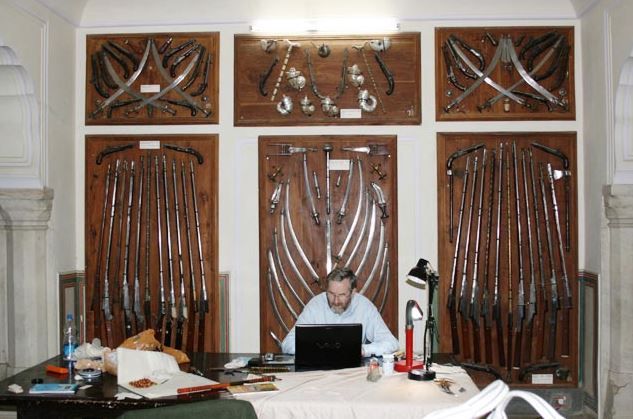New Delhi: International arms expert Robert Elgood explores historic Indian firearms in a new book by focusing on the famed Jodhpur collection that includes the best Indian matchlocks, modern British and American sporting guns, shotguns, revolvers and automatic pistols.
In 1972, Maharaja Gaj Singh of Jodhpur-Marwar transformed the Mehrangarh Fort into a Rajput museum and cultural centre. As part of this work, the Mehrangarh Museum Trust commissioned the book “The Maharaja of Jodhpur’s Guns”.
According to publishers Niyogi Books, this is the first specific work on historic Indian firearms by an international arms expert.
Elgood says the early history of gunpowder and firearms in India is complex, regional and often depends on questionable or ambiguous textual evidence.
The initial chapters talk about the invention of gunpowder weapons and their arrival in medieval India, matchlock guns with revolving mechanisms in the Portuguese eastern empire, and the Indian matchlock.
The book then showcases numerous lamchars, swivel guns or Shuturnals, 17th-19th century banduks, Sindhi jezails, Balochistan matchlocks, Indian blunderbusses, matchlock pistols and combination weapons, powder flasks, miniature cannon, British military guns, European civilian guns, 19th- and 20th-century European and American pistols, and late 19th- and 20th-century air pistols.
It also includes an analysis of advances in sporting guns in India in the 19th century, a chapter on hunting with spear and gun in Rajasthan, a set of pages transcribed from the 1926 hunting diary of Maharaja Umaid Singh, and a catalogue of his sporting guns.
Among the weapons mentioned in the book is the disguised .22 pen-pistol, one of the inventions of Maharaja Hanwant Singh of Jodhpur. His son Gaj Singh II says the maharaja took his passion for guns to a different dimension; setting up a gun factory in Mehrangarh Fort, and designing his own firearms.
The maharaja made pencil guns in his workshop and gave some to friends.
Elgood mentions an incident when the maharaja had one of these ”pens” in his pocket when he once went to a meeting in Delhi. V P Menon, political advisor to Lord Mountbatten, had led the maharaja to believe that the British officer was expecting him.
“The maharaja became extremely irritated at being kept waiting and finally, when admitted to Menon’s office, pulled out the pistol and in mock anger threatened to shoot him. Mountbatten walked in on the scene. The maharaja explained that he was showing his new invention to Menon and gave Mountbatten the pistol as a gift,” Elgood writes.
After Mountbatten’s death, the pistol was auctioned at Holts in 2010 and was bought by a private collector.
The book features more than 350 images of guns and Rajput paintings from private collections showing their use. It not only showcases the guns and arms and the tales of their inception, but also takes one along in its quest of stories through many paintings of the respective eras that keep a clear statement on the socio-cultural narrative of this grand journey.
The author discusses the worldwide medieval diffusion of firearms technology and Arab, Ottoman, European and Chinese influences on the development of Indian firearms.
Jodhpur was one of the most important military states in Rajasthan, playing a major role in the history of the subcontinent, never more so than during the reign of Maharaja Ajit Singh (1678–1724) who purchased large numbers of guns when his daughter married the Mughal emperor.
Jodhpur owns the best Indian matchlocks in the subcontinent, much admired at the Delhi Durbar in 1911. Successive maharajas have added to the collection.
Elgood, who has worked at Sotheby”s and the Wallace Collection and as a guest scholar or consultant at various major museums, has authored numerous books including “Arms and Armour at the Jaipur Court” (2015) and “Rajput Arms and Armour: The Rathores and their Armoury at Jodhpur Fort” (2017). PTI





